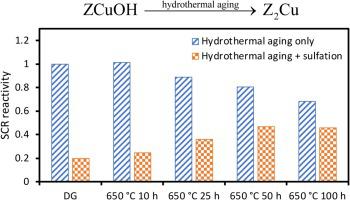Applied Catalysis B: Environment and Energy ( IF 20.2 ) Pub Date : 2020-11-24 , DOI: 10.1016/j.apcatb.2020.119749 Yuanzhou Xi , Changsheng Su , Nathan A. Ottinger , Z. Gerald Liu

|
Cu-SSZ-13 catalysts have been widely used for NOx reduction via SCR for diesel aftertreatment applications due to their high SCR efficiency. Hydrothermal aging and sulfur poisoning are two areas of research on Cu-SSZ-13 catalysts due to their significant relevance to real world applications. In addition to the effects of 650 °C hydrothermal aging, this work also investigates the corresponding sulfur poisoning effects upon aging. Hydrothermal aging results in decreasing SCR reactivity with constant activation energy. Upon sulfation at 400 °C, the catalyst displays decreasing SCR reactivity with lower activation energy. However, upon longer aging duration prior to sulfation, the decrease in SCR reactivity becomes less and the catalyst becomes more resistant toward sulfur poisoning with less sulfur loading. The enhanced sulfur poisoning resistance of Cu-SSZ-13 catalyst can be mainly ascribed to the gradual conversion of ZCuOH to Z2Cu upon aging as suggested by results from NH3 TPD and DRIFTS.
中文翻译:

水热老化对Cu-SSZ-13 SCR催化剂硫中毒的影响
Cu-SSZ-13催化剂已被广泛用于NO x柴油后处理应用中的SCR效率高,因此可通过SCR减少排放。水热老化和硫中毒是Cu-SSZ-13催化剂的两个研究领域,因为它们与现实世界的应用密切相关。除了650°C水热老化的影响外,这项工作还研究了相应的硫中毒对老化的影响。水热老化导致具有恒定活化能的SCR反应性降低。在400℃下硫酸化时,催化剂显示出降低的SCR反应性和较低的活化能。然而,在硫酸化之前较长的老化持续时间下,SCR反应性的降低变得更少,并且催化剂变得对硫中毒具有更强的抵抗力,同时硫载量更少。如NH 3 TPD和DRIFTS的结果所示,老化时会生成2 Cu 。











































 京公网安备 11010802027423号
京公网安备 11010802027423号